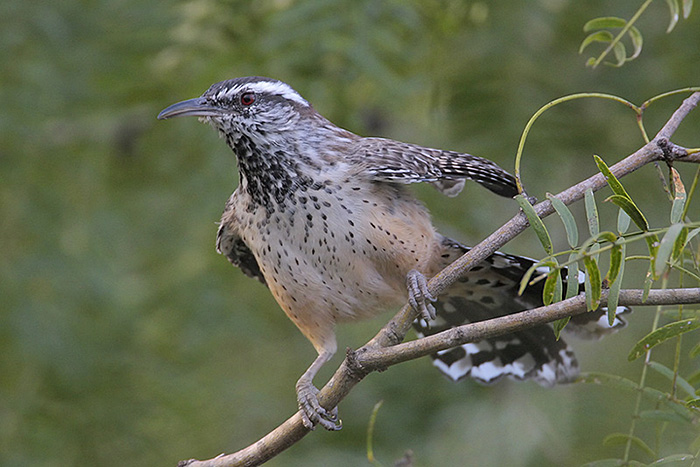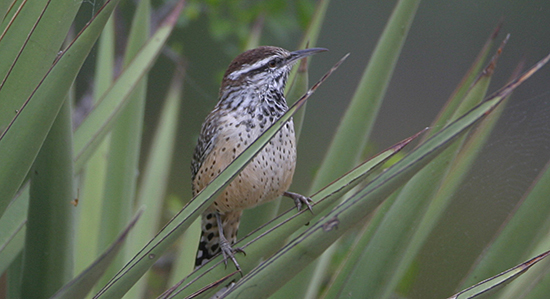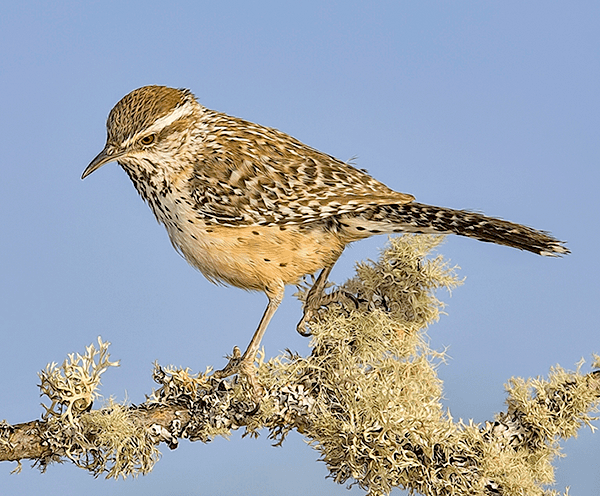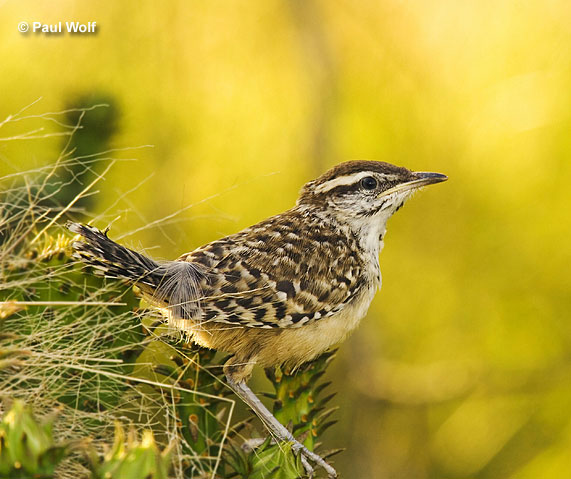
Arizona is the sixth largest state in the USA and its official state bird is Cactus Wren. Although many people associate this 113,990 square mile state with Saguaro Cactus and deserts, in the northern and southeastern regions of the state, conifer-clad mountains are an essential part of the local landscape.
Arizona receives a large number of tourists and most of them visit the Grand Canyon. However, Arizona is also a popular destination for birdwatchers who look for various species, especially in the southeastern part of the state. This scenic state’s combination of montane and arid habitats give Arizona an impressive bird list replete with desert specialties and species mostly found in Mexico.
One of those special birds is the Cactus Wren, the official state bird of Arizona. The Cactus Wren is a large, arboreal wren species that lives in the southern half of Arizona as well as other parts of the American southwest and Mexico.
True to its name, it is often seen perched on cactus plants and is a common and conspicuous bird in much of its range.
On this page
History
The Cactus Wren became the official state bird of Arizona on March 18, 1931, 19 years after Arizona achieved statehood. At this time in history, as was the case for many other states, the General Federation of Women’s Clubs hoped to have state birds named before their biennial council meeting in 1931.
To help make this happen, they lobbied state legislatures to choose an official state bird in the years and months leading up to 1931. Their choice for Arizona was the Cactus Wren because they believed this industrious and bold bird represented the “can-do” attitude of Arizonans.

The Arizona state legislature agreed that the Cactus Wren was the perfect candidate. Not only does this fun species mirror the adaptive and industrious abilities of the people of Arizona, but it is also a common and familiar bird around Phoenix and many other parts of the state.
Although it does occur in some other parts of the country and in Mexico, they viewed the Cactus Wren as a “true son” of Arizona because the bird is especially common there and a signature species of desert environments.
In many parts of Arizona, in 1931, folks with a garden, or indeed, any degree of desert vegetation around their house, couldn’t help but notice the loud voice, obvious nest, and antics of this distinctive bird.
In modern times, the Cactus Wren continues to be an essential species of arid habitat in the state.
Facts about The Arizona State Bird
- Cactus Wrens almost never drink water. As with some other birds adapted to arid places, they get all of their needed moisture from the insects and fruit they feed on. They can also get moisture from drinking cactus sap from woodpecker holes, and while taking nectar from flowers.
- Cactus Wrens can’t stop building nests. These busy birds build a number of bulky nests to roost in, even when they aren’t laying any eggs. Juvenile birds also start to build nests, often, shortly after they leave their own nest!
- The Cactus Wren is the largest wren species in the USA and is more related to wrens in Mexico and Central America than it is to the House Wren, Carolina Wren, and other wren species.
- True to its name, the Cactus Wren usually builds its nest in a cactus plant. In Arizona, they often use the Saguaro Cactus.
- Cactus Wrens are not very friendly to other birds; they commonly attack and destroy the nests and eggs of other desert bird species including Verdins.
Identification
The Cactus Wren is the largest wren species in the USA, weighs 40 grams, and is much bigger than other, commonly seen wren species.
Measuring a whopping eight inches long, it’s a little bit larger than a Red-winged Blackbird, and three inches longer than the House Wren.
The male Cactus Wren is slightly larger than the female but the difference is too small to notice without carefully measuring the birds in the hand.
Both sexes look the same and have a rather long, sharp, dark, curved bill, and strong legs and feet for hopping on the ground, and grasping cactus and other desert plants.

Photograph © Alan Wilson.
The Cactus Wren also has a prominent white eyebrow, a dark brown cap, and a black line through a brown eye. The part of the face below the eye is mottled with brown and black and white markings, and it has white on the upper part of the throat.
On the lower part of the throat and breast, the Cactus Wren has black marks and patches. The lower breast and belly is white and buff with small black spots. The back and wings are grayish-brown with short white streaks and black and white marks, and the grayish-brown tail is fairly long with black and white on the outer tail feathers.
In brief bouts of flight between cactus and other vegetation, the Cactus Wren’s short, rounded wings look blackish with small white spots, and the spread tail looks dark with a white tip and black and white marks, especially on the outer tail feathers.
Call
The Cactus Wren has a loud, chattering, mechanical-sounding song that lasts around four seconds. Males sing from a prominent perch, often singing 20 or even 30 times in a row to establish their territory and/or a attract a mate.
Females can also sing, but their song is quieter and higher-pitched than males, and they don’t sing as often. Both sexes also make short buzzy, and harsh calls while foraging and communicating with their mates.
The song and calls of the Cactus Wren are unique and sound nothing like the melodious notes of other wren species, nor anything else in their range. When we hear a raspy, mechanical noise sounding somewhat like an old chugging train in the deserts of the American southwest, it’s usually a Cactus Wren.
When we aren’t in the desert, one easy way to hear the Cactus Wren is to watch old movies and TV shows. This species sings so often, it has been frequently recorded in the background of movies and shows filmed in southern California, and natural soundtracks featuring the song are also commonly used.
Behavior
Cactus Wrens usually occur as pairs and spend most of their time building nests, singing from prominent perches, and foraging in shaded spots on the ground, and in desert vegetation.

The Cactus Wren is a bold bird that won’t hesitate to protect its nest from squirrels and other animals. When protecting the nest, both sexes harass the intruder with harsh call notes, and use their strong bills to peck it.
They are especially aggressive with ground-squirrels, snakes, and other small mammals, animals that are important nest predators of the Cactus Wren.
Predators of the Cactus Wren include Bull Snakes and other snake species that would eat the eggs and nestlings, domestic cats, Greater Roadrunners, and various hawks. Harris’s Hawks in particular will catch Cactus Wrens if the opportunity presents itself.
Cactus Wrens aren’t particularly afraid of people and will nest in a backyard or garden as long as there is plenty of unfragmented, wild habitat nearby.
Which Common Birds Can You See In Arizona?
As a southern state, Arizona often sees wintering birds and other species that might not travel all the way to more northern states. With over 550 species, there is a lot to see!
Here are some of the more common ones:
- Mourning Dove
- House Finch
- Gila Woodpecker
- Verdin
- Lesser Goldfinch
- Common Raven
- Anna’s Hummingbird
See more – Most common birds
You Might Ask
What is the state bird of Arizona?
The state bird of Arizona is the Cactus Wren.
Why is the Cactus Wren the state bird of Arizona?
The Cactus Wren is the state bird of Arizona because it is a native bird species that is closely associated with the desert landscapes of the state. It is known for its resilient nature and its ability to adapt to the arid conditions of the desert. The Cactus Wren’s unique appearance and its intricate nests, which are often built in cacti, make it a fitting symbol of Arizona’s rugged beauty and wildlife.
When did Arizona choose its state bird?
Arizona designated the Cactus Wren as its state bird in 1931.
What other states have the Cactus Wren as their state bird?
The Cactus Wren is solely recognized as the state bird of Arizona and does not hold the same designation in any other states.

